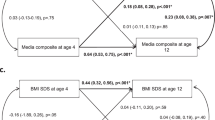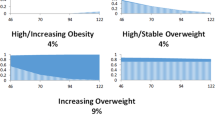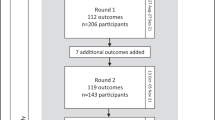Abstract
Background:
The Be Active Eat Well (BAEW) community-based child obesity prevention intervention was successful in modestly reducing unhealthy weight gain in primary school children using a multi-strategy and multi-setting approach.
Objective:
To (1) examine the relationship between changes in obesity-related individual, household and school factors and changes in standardised child body mass index (zBMI), and (2) determine if the BAEW intervention moderated these effects.
Methods:
The longitudinal relationships between changes in individual, household and school variables and changes in zBMI were explored using multilevel modelling, with measurement time (baseline and follow-up) at level 1, individual (behaviours, n=1812) at level 2 and households (n=1318) and schools (n=18) as higher levels (environments). The effect of the intervention was tested while controlling for child age, gender and maternal education level.
Results:
This study confirmed that the BAEW intervention lowered child zBMI compared with the comparison group (−0.085 units, P=0.03). The variation between household environments was found to be a large contributor to the percentage of unexplained change in child zBMI (59%), compared with contributions from the individual (23%) and school levels (1%). Across both groups, screen time (P=0.03), sweet drink consumption (P=0.03) and lack of household rules for television (TV) viewing (P=0.05) were associated with increased zBMI, whereas there was a non-significant association with the frequency the TV was on during evening meals (P=0.07). The moderating effect of the intervention was only evident for the relationship between the frequency of TV on during meals and zBMI, however, this effect was modest (P=0.04).
Conclusions:
The development of childhood obesity involves multi-factorial and multi-level influences, some of which are amenable to change. Obesity prevention strategies should not only target individual behaviours but also the household environment and family practices. Although zBMI changes were modest, these findings are encouraging as small reductions can have population level impacts on childhood obesity levels.
This is a preview of subscription content, access via your institution
Access options
Subscribe to this journal
Receive 12 print issues and online access
$259.00 per year
only $21.58 per issue
Buy this article
- Purchase on Springer Link
- Instant access to full article PDF
Prices may be subject to local taxes which are calculated during checkout
Similar content being viewed by others

References
Flynn MAT, McNeil DA, Maloff B, Mutasingwa D, Wu M, Ford C et al. Reducing obesity and related chronic disease risk in children and youth: A synthesis of evidence with ‘best practice’ recommendations. Obes Rev 2006; 7: 7–66.
Bronfenbrenner U . Ecology of the family as a context for human development: research perspectives. Dev Psychol 1986; 22: 723–742.
Nutbeam D, Harris E . Theory in a Nutshell: A Practical Guide to Health Promotion Theories. McGraw-Hill: Sydney, Australia, 2004.
World Health Organization. Ottawa Charter for Health Promotion, WHO: Geneva, 1986.
Lobstein T, Baur L, Uauy R . Obesity in children and young people: a crisis in public health. Obes Rev 2004; 5: 4–85.
Procter KL . The aetiology of childhood obesity: a review. Nutr Res Rev 2007; 20: 29–45.
Vartanian LR, Schwartz MB, Brownell KD . Effects of soft drink consumption on nutrition and health: a systematic review and meta analysis. Am J Public Health 2007; 97: 667–675.
Sanigorski AM, Bell AC, Swinburn BA . Association of key foods and beverages with obesity in Australian school children. Public Health Nutr 2007; 10: 152–157.
Davison KK, Birch LL . Childhood overweight: a contextual model and recommendations for future research. Obes Rev 2001; 2: 159–171.
Davison KK, Birch LL . Obesigenic families: parents’ physical activity and dietary intake patterns predict girls’ risk of overweight. Int J Obes 2002; 26: 1186–1193.
Campbell K, Crawford D, Ball K . Family food environment and dietary behaviors likely to promote fatness in 5–6 year-old children. Int J Obes 2006; 30: 1272–1280.
Gable S, Lutz S . Household, parent, and child contributions to childhood obesity. Fam Relations 2000; 49: 293–300.
Gibson LY, Byrne SM, Davis EA, Blair E, Jacoby P, Zubrick SR . The role of family and maternal factors in childhood obesity. Med J Australia 2007; 186: 591–595.
Wang Y . Cross-national comparison of childhood obesity: the epidemic and the relationship between obesity and socioeconomic status. Int J Epidemiol 2001; 30: 1129–1136.
Golan M, Crow S . Targeting parents exclusively in the treatment of childhood obesity: long-term results. Obes Res 2004; 12: 357–361.
de Silva-Sanigorski AM, Economos C . Evidence of multi-setting approaches for obesity prevention: translation to best practice. In: Waters E, Seidell J, Swinburn BA (eds). Preventing Childhood Obesity: Evidence, Policy and Practice. Blackwell Publishing Ltd: Oxford, 2010, pp 57–63.
Economos CD, Hyatt RR, Goldberg JP, Must A, Naumova EN, Collins JJ et al. A community intervention reduces BMI z-score in children: shape up Somerville first year results. Obesity 2007; 15: 1325–1336.
Taylor RW, McAuley KA, Barbezat W, Strong A, Williams SM, Mann JI . APPLE Project: 2-y findings of a community-based obesity prevention program in pimary school age children. Am J Clin Nutr 2007; 86: 735–742.
Sanigorski AM, Bell AC, Kremer PJ, Cuttler R, Swinburn BA . Reducing unhealthy weight gain in children through community capacity-building: results of a quasi-experimental intervention program, Be Active Eat Well. Int J Obes 2008; 32: 1060–1067.
de Silva-Sanigorski AM, Bell AC, Kremer P, Nichols M, Crellin M, Smith M et al. Reducing obesity in early childhood: results from Romp & Chomp, an Australian community-wide intervention program. Am J Clin Nutr 91: 831–840.
Millar L, Kremer P, de Silva-Sanigorski A, McCabe MP, Mavoa H, Moodie M et al. Reduction in overweight and obesity from a 3-year community-based intervention in Australia: the ‘It's Your Move!’ project. Obes Rev 2011; 12 (Suppl 2): 20–28.
Sanigorski AM, Bell AC, Kremer PJ, Swinburn BA . High childhood obesity in an Australian population. Obesity 2007; 15: 1908–1912.
Bell AC, Simmons A, Sanigorski AM, Kremer PJ, Swinburn BA . Preventing childhood obesity: the sentinel site for obesity prevention in Victoria, Australia. Health Promot Int 2008; 23: 328–336.
Davies P, Roodvelt R, Marks G . Standard Methods for the Collection and Collation of Anthropometric Data in Children. Commonwealth of Australia: Canberra, 2001.
Vidmar S, Carlin J, Hesketh K, Cole T . Standardizing anthropometric measures in children and adolescents with new functions for egen. Stata J 2004; 4: 50–55.
Edmunds LD, Ziebland S . Development and validation of the Day in the Life Questionnaire (DILQ) as a measure of fruit and vegetable questionnaire for 7–9 year olds. Health Educ Res 2002; 17: 211–220.
Sallis JF, Proschaska JJ, Wendell CT . A review of correlates of physical activity of children and adolescents. Med Sci Sports Exerc 2000; 32: 963–975.
Raudenbush SW, Bryk AS . Hierarchical Linear Models: Applications and Data Analysis Methods. Sage Publications: Thousand Oaks, CA, 2002.
Rasbash J, Charlton C, Browne WJ, Healy M, Cameron B . MLwiN Version 2.02. Centre for Multilevel Modelling: University of Bristol, Bristol, UK, 2005.
Hox JJ . Multilevel Analysis: Techniques and Applications. Lawrence Erlbaum Associates, Inc.: Mahwah, New Jersey, 2002.
Rasbash J, Steele F, Browne W, Prosser B . A User's Guide to MLwiN 2.02. Centre for Multilevel Modelling, University of Bristol: London, 2004.
Forshee RA, Anderson PA, Storey ML . Sugar-sweetened beverages adn body mass index in children and adolescents: A meta-analysis. Am J Clin Nutr 2008; 87: 1662–1671.
Ludwig DS, Peterson KE, Gortmaker SL . Relation between consumption of sugar-sweetened drinks and childhood obesity: a prospective, observational analysis. Lancet 2001; 357: 505–508.
Hancox RJ, Milne BJ, Poulton R . Association between child and adolescent television viewing and adult health: a longitudinal birth cohort study. Lancet 2004; 364: 257–262.
Epstein LH, Roemmich JN, Robinson JL, Paluch RA, Winiewicz DD, Fuerch JH et al. A randomized trial of the effects of reducing television viewing and computer use on body mass index in young children. Arch Pediatr Adolesc Med 2008; 162: 239–245.
Dietz WH, Gortmaker SL . Do we fatten our children at the television set? Obesity and television viewing in children and adolescents. Pediatrics 1985; 75: 807–812.
Marshall SJ, Biddle SJH, Gorely T, Camerson N, Murdey I . Relationships between media use, body fatness and physical activity in children and youth: A meta analysis. Int J Obes 2004; 28: 1238–1246.
Caroli M, Argentieri L, Cardone M, Masi A . Role of television in childhood obesity prevention. Int J Obes 2004; 28: S104–S108.
Coon KA, Goldberg J, Rogers BL, Tucker KL . Relationships between use of television during meals and children's food consumption patterns. Pediatrics 2001; 107: 1–9.
van Zutphen M, Bell AC, Kremer PJ, Swinburn BA . Association between the family environment and television viewing in Australian children. J Paediatr Child Health 2007; 43: 458–463.
Salmon J, Timperio A, Telford A, Carver A, Crawford D . Association of family environment with children's television viewing and with low level of physical activity. Obes Res 2005; 13: 1939–1951.
Barradas DT, Fulton JE, Blanck HM, Huhman M . Parental influences on youth television viewing. J Pediatr 2007; 151: 369–373.
Rose G, Day S . The population mean predicts the number of deviant individuals. BMJ 1990; 301: 1031–1034.
Butte N, Ellis K . Comment on “Obesity and the environment: where do we go from here?” Science 2003; 301: 598.
Acknowledgements
This research was supported by the Commonwealth Department of Health and Ageing, the Victorian Department of Human Services and the Victorian Health Promotion Foundation (VicHealth). Andrea de Silva-Sanigorski was supported by a VicHealth Public Health Research Fellowship and the Jack Brockhoff Child Health and Wellbeing Program. We would like to acknowledge the Deakin University evaluation staff, Colac Otway Shire, Colac Area Health, and the staff, students and parents from the participating communities.
Author information
Authors and Affiliations
Corresponding author
Ethics declarations
Competing interests
The authors declare no conflict of interest.
Rights and permissions
About this article
Cite this article
Johnson, B., Kremer, P., Swinburn, B. et al. Multilevel analysis of the Be Active Eat Well intervention: environmental and behavioural influences on reductions in child obesity risk. Int J Obes 36, 901–907 (2012). https://doi.org/10.1038/ijo.2012.23
Received:
Revised:
Accepted:
Published:
Issue Date:
DOI: https://doi.org/10.1038/ijo.2012.23
Keywords
This article is cited by
-
Healthy together Victoria and childhood obesity study: effects of a large scale, community-based cluster randomised trial of a systems thinking approach for the prevention of childhood obesity among secondary school students 2014–2016
BMC Public Health (2024)
-
The effectiveness of pediatric obesity prevention policies: a comprehensive systematic review and dose–response meta-analysis of controlled clinical trials
Journal of Translational Medicine (2020)
-
Whole systems approaches to obesity and other complex public health challenges: a systematic review
BMC Public Health (2019)
-
Family food environment factors associated with obesity outcomes in early childhood
BMC Obesity (2019)
-
Study protocol of the quasi-experimental evaluation of “KEIGAAF”: a context-based physical activity and nutrition intervention for primary school children
BMC Public Health (2018)


